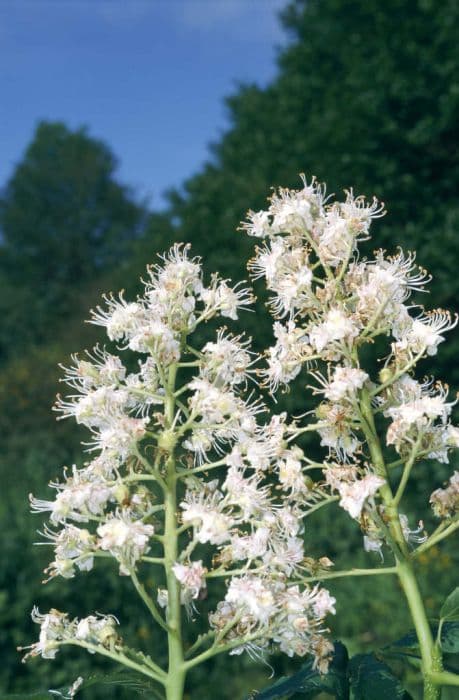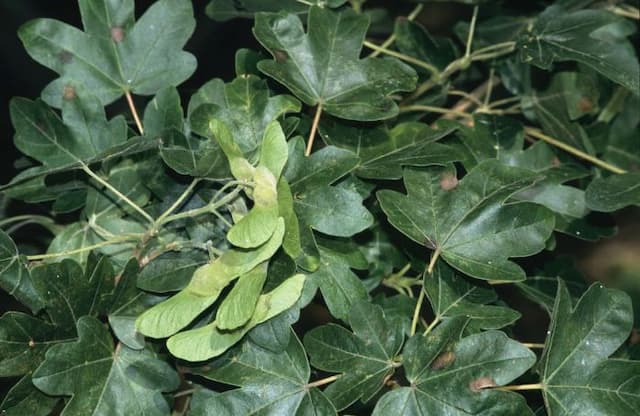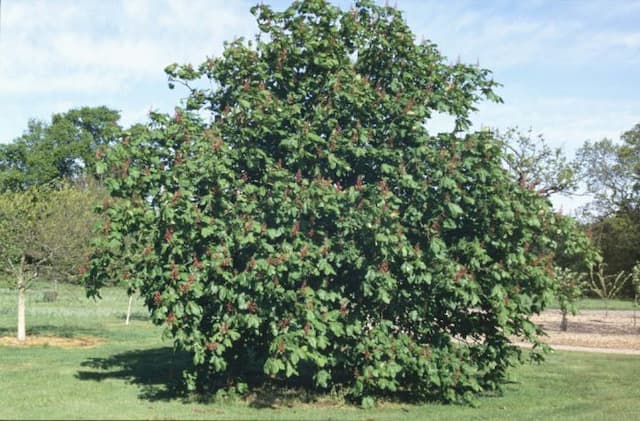Bottlebrush Buckeye Aesculus parviflora

ABOUT
The plant commonly known as the Bottlebrush Buckeye is characterized by its distinctive long and fluffy white flowers that resemble a traditional bottlebrush, hence the name. These flowers are arranged in panicles that bloom prolifically during the summertime, drawing in pollinators with their showy appearance. The leaves of the Bottlebrush Buckeye are lush green with a compound structure, featuring multiple leaflets that stem from a single point, giving them a palmate form. As the seasons turn, these leaves transform to a lovely shade of yellow, providing an attractive autumnal display. The plant also produces smooth, brown, inedible nuts encased in a husk that adds to its ornamental value. The overall form of the Bottlebrush Buckeye can be described as rounded and spreading, which lends itself to a bushy, shrub-like appearance that enhances the aesthetic of any garden setting.
About this plant
 Names
NamesFamily
Sapindaceae
Synonyms
Bottlebrush Buckeye, Dwarf Buckeye
Common names
Aesculus macrostachya, Aegeirus macrostachys, Aesculus macrostachys, Pavia macrostachya.
 Toxicity
ToxicityTo humans
The plant Aesculus parviflora, commonly known as the bottlebrush buckeye, contains toxic compounds, particularly glycosides and saponins, that can be harmful if ingested. Parts of the plant, particularly the seeds, can be poisonous to humans. Symptoms of poisoning may include nausea, diarrhea, stomach cramps, and lethargy. In severe cases, muscle weakness and coordination problems may also occur. It is important to seek medical attention if ingestion is suspected.
To pets
The plant Aesculus parviflora, known as bottlebrush buckeye, is toxic to pets, including dogs and cats. The main toxic components are glycosides and saponins, particularly concentrated in the seeds. If a pet ingests parts of this plant, symptoms can include vomiting, diarrhea, depression, weakness, and, in more severe cases, dilated pupils and convulsions. Immediate veterinary care should be sought if a pet has ingested any part of the bottlebrush buckeye.
 Characteristics
CharacteristicsLife cycle
Perennials
Foliage type
Deciduous
Color of leaves
Green
Flower color
White
Height
6-8 feet (1.8-2.4 meters)
Spread
8-10 feet (2.4-3 meters)
Plant type
Shrub
Hardiness zones
4
Native area
Southeastern United States
Benefits
 General Benefits
General Benefits- Attracts Wildlife: Aesculus parviflora, commonly known as bottlebrush buckeye, is particularly good at attracting butterflies, bees, and other beneficial pollinators to the garden due to its showy flowers.
- Landscape Beautification: With its long, panicle-like flowers and lush foliage, bottlebrush buckeye is often used as a decorative element in landscaping, enhancing the aesthetic appeal of the environment.
- Erosion Control: The spreading nature and dense growth of bottlebrush buckeye can help stabilize soil and prevent erosion on slopes or in areas prone to losing topsoil.
- Shade Provider: As bottlebrush buckeye matures and grows, it can provide considerable shade in gardens and yards, creating cool areas during hot summer months.
- Habitat Creation: This plant can contribute to creating a diverse ecosystem by offering shelter and food sources for various small animals and insects.
- Seasonal Interest: Bottlebrush buckeye has a seasonal progression of interest, from spring foliage to summer flowers and golden fall color, adding dynamic changes to the landscape throughout the year.
 Medical Properties
Medical PropertiesThis plant is not used for medical purposes.
 Air-purifying Qualities
Air-purifying QualitiesThis plant is not specifically known for air purifying qualities.
 Other Uses
Other Uses- Wildlife habitat: Bottlebrush Buckeye provides dense foliage that can serve as shelter for small animals and birds.
- Natural fence: Due to its dense and spreading nature, it can be used to create living privacy screens in gardens.
- Erosion control: Its extensive root system helps stabilize soil and prevent erosion on slopes and banks.
- Garden architecture: Its distinctive shape and flowering spikes provide strong vertical interest in landscape designs.
- Education: Botanical gardens and educational facilities use Bottlebrush Buckeye to teach pollination biology due to its attractiveness to pollinators.
- Photography: The striking flowers make it a popular subject for garden photographers and enthusiasts.
- Culinary garnish: Though not widely known, the flowers may be used as a decorative, non-toxic garnish for certain dishes.
- Eco-friendly dye: The bark and leaves could potentially be used to create natural dyes for fabrics or crafts.
- Companion planting: It can be used in gardens to attract pollinators that benefit other nearby plants.
- Lively fall color: Its foliage provides vibrant yellow and orange hues in autumn, valuable for seasonal displays.
Interesting Facts
 Feng Shui
Feng ShuiThe Bottlebrush Buckeye is not used in Feng Shui practice.
 Zodiac Sign Compitability
Zodiac Sign CompitabilityThe Bottlebrush Buckeye is not used in astrology practice.
 Plant Symbolism
Plant Symbolism- Strength and Endurance: The Aesculus parviflora, commonly known as the Bottlebrush Buckeye, typically represents strength and endurance due to its robust and resilient nature, able to thrive in a variety of conditions and resist different environmental stresses.
- Protection: With its dense foliage and the historical use of buckeyes as protective charms, the Bottlebrush Buckeye is often associated with protection, symbolizing the ability to shield oneself or others from harm.
- New Beginnings: The Bottlebrush Buckeye, like many plants, can symbolize new beginnings, as it flowers and leaves out in the spring, representing growth and the start of new cycles in life.
- Victory: Based on the buckeye's association with Ohio, known as the "Buckeye State", where Ohio State University's sports teams are named the Buckeyes, it can also symbolize victory and success, specifically in competitive endeavors.
 Water
WaterBottlebrush Buckeye requires regular watering, particularly during dry spells. In the first growing season, it's crucial to establish a deep root system, so water deeply once a week, pouring slowly to a depth of 8 inches. Once established, it will need less frequent watering, but ensure the soil remains moist, not waterlogged. During summer, water with approximately 1.5 gallons per square yard every week to ten days, adjusting based on rainfall and temperature. Water in the morning to reduce evaporation and minimize disease risk.
 Light
LightBottlebrush Buckeye thrives in partial shade to full shade. It's best situated in a location that receives filtered sunlight or morning sun with afternoon shade. Avoid placing it in full sun, as this can lead to leaf burn, especially in hotter climates.
 Temperature
TemperatureBottlebrush Buckeye is hardy and can tolerate a wide range of temperatures but performs best in areas where the average summer temperature doesn't exceed 90 degrees Fahrenheit. It can survive minimum winter temperatures down to -20 degrees Fahrenheit. Ideally, maintain an environment between 60 and 80 degrees Fahrenheit for optimal growth.
 Pruning
PruningPrune Bottlebrush Buckeye to maintain shape and remove dead or damaged branches. The best time for pruning is late winter or early spring before new growth starts. It typically doesn't require heavy pruning; just cut back as needed to keep it tidy. Prune every 2-3 years or as necessary to manage its size.
 Cleaning
CleaningAs needed
 Soil
SoilBottlebrush Buckeye thrives in moist, well-drained soil with a pH of 5.5 to 6.5. An optimal mix would be 50% loam, 30% compost, and 20% coarse sand to ensure proper drainage and fertility.
 Repotting
RepottingBottlebrush Buckeye is typically not repotted as it is a large shrub; it's planted outdoors where it has room to grow and does not require repotting.
 Humidity & Misting
Humidity & MistingBottlebrush Buckeye prefers moderate humidity levels but is quite adaptable and does not require a specific humidity range to thrive.
 Suitable locations
Suitable locationsIndoor
Not suited for indoor growth; it’s a large outdoor shrub.
Outdoor
Plant in partial shade, ensure soil is moist and well-drained.
Hardiness zone
4-8 USDA
 Life cycle
Life cycleThe Bottlebrush Buckeye (Aesculus parviflora) begins its life cycle as a seed, usually germinating after experiencing a period of cold stratification that simulates winter. Upon germination, the seedling emerges, developing into a young plant with characteristic palmately compound leaves. As the plant matures, it grows into a large shrub with a suckering habit, spreading through underground stems, called rhizomes, to form colonies. Annually during summer, it produces showy, elongated clusters of white flowers with red anthers or pink filaments, attracting pollinators. Following pollination, the plant produces fruit in the form of a leathery capsule containing one to few dark brown seeds. The Bottlebrush Buckeye can live for many years, spreading and reseeding in appropriate conditions, continuing its life cycle as seeds fall to the ground and new plants eventually grow.
 Propogation
PropogationPropogation time
Spring to summer
The most popular method of propagating the Bottlebrush Buckeye (Aesculus parviflora) is through seed collection and sowing. The best time to collect seeds is in the fall when the nuts are mature and dropping from the tree. Once collected, it is critical to plant the seeds immediately as they do not store well and can quickly lose viability. To propagate, choose a well-draining soil mix and sow the seeds about 1 to 2 inches deep (2.5 to 5 cm deep), spaced at least a few inches apart to allow for growth. Water the soil to keep it consistently moist until germination occurs. It is important to note that seed-grown plants will not flower for several years as they need time to mature.









